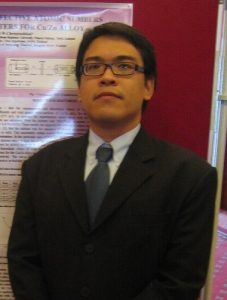
Keynote Address
“Enhancement of luminescence light yield of Ln3+ doped glass by oxyfluoride glass matrix”
Glass is a good material which received attention for doping lanthanide ions. Glass doped Ln3+ ions can show luminescence, but not too strong light yield. It is well known that the host glass plays an important role in the enhancement. This paper has been described effect of Ln3+ ions (Sm3+, Eu3+ and Dy3+) doped oxyfluoride glass by comparing between oxide and oxyfluoride glasses. For the Sm3+ doped gadolinium calcium phosphate oxyfluoride glass, the highest emission peak was 598 nm under 401 nm excitation. While the emission light yield of oxyfluoride glass was higher than oxide glass due to the reduction of phonon and non-radiative losses. In case of Eu3+ doped oxyfluoride glass, the 612 nm emission under 394 nm excitation was observed. The light yield of oxyfluoride glass also was better than oxide glass. The Dy3+-doped phosphate oxide and oxyfluoride glasses were investigated. The luminescence light yield of oxyfluoride glass was more than oxide glass as well, owing to lower OH group of oxyfluoride glass, which can be confirmed by FTIR measurement. As described earlier, it concludes that the oxyfluoride glass is better than glass matrix when compared with oxide glass to enhance luminescence light yield for Ln3+ ions in glass matrix.
lanthanide ions; oxide glass; oxyfluoride glass; phonon energy
Research Field Keywords
Glass; Limninescence; gemstone; shielding
Affiliations
- Center of Excellence in Glass Technology and Materials Science , Nakhon Pathom Rajabhat University, Thailand, 2002 -present
Education
- Doctorate: Physics, King Monugut University of Technology Thonbiru, Thailand, 2008
- Master’s: Physics, King Monugut University of Technology Thonbiru, Thailand, 2004
- Bachelor’s: Physics, Silpakorn University, Thailand, 2000
Additional Information
Assoc.Prof.Dr.Jakrapong Kaewkhao received Ph.D. degree in physics from King Mongkut’s University of Technology Thonburi (KMUTT), Thailand, in 2008. 2012, he has been awarded as the best alumni of Silpakorn University, Thailand. Through his academic career, his research interests involve glass scintillators, Ln3+ doped in glasses for luminescence applications, color glasses, radiation shielding glasses (gamma and neutron), natural gemstone enhancements, and imitation jewelry from glasses. His research on imitation jewelry from glasses has been awarded by several national organizations, e.g., Thailand Research Fund (TRF), National Innovation Agency (NIA), The Science Society of Thailand (SST), and National Research Council of Thailand (NRCT). His recent work focuses on the development of imitation of color-changed gemstone for ornament products, and has recently been awarded by National Research Council of Thailand (NRCT) in 2015. This project has also been awarded the Best Innovation Awards by the 43rd International Exhibition of Innovation of Geneva, Switzerland, and the Medaille D’Argent Silver Medal Silbermadaille in 2015 and Seoul International Invention Fair in 2016. Recently, He has been awarded by National Research Council of Thailand (NRCT) in 2017 from research project “Development of lead free glass for radiation shielding material”.
Currently, he is director of the Center of Excellence in Glass Technology and Materials Science (CEGM), Nakhon Pathom Rajabhat University (NPRU), Thailand. He has handled 60 research projects in glass science and technology, radiation physics, and gemstone enhancements (principal investigator 32 projects). He is a member of AMoRE collaboration (Advanced Molybdenum Based Rare Experiment), to search mass of neutrinos, which supported by Institute for Basic Science (IBS, Korea). He has published 247 papers in international journals, 955 citations and H-index = 16 (Data obtained from Scopus).
